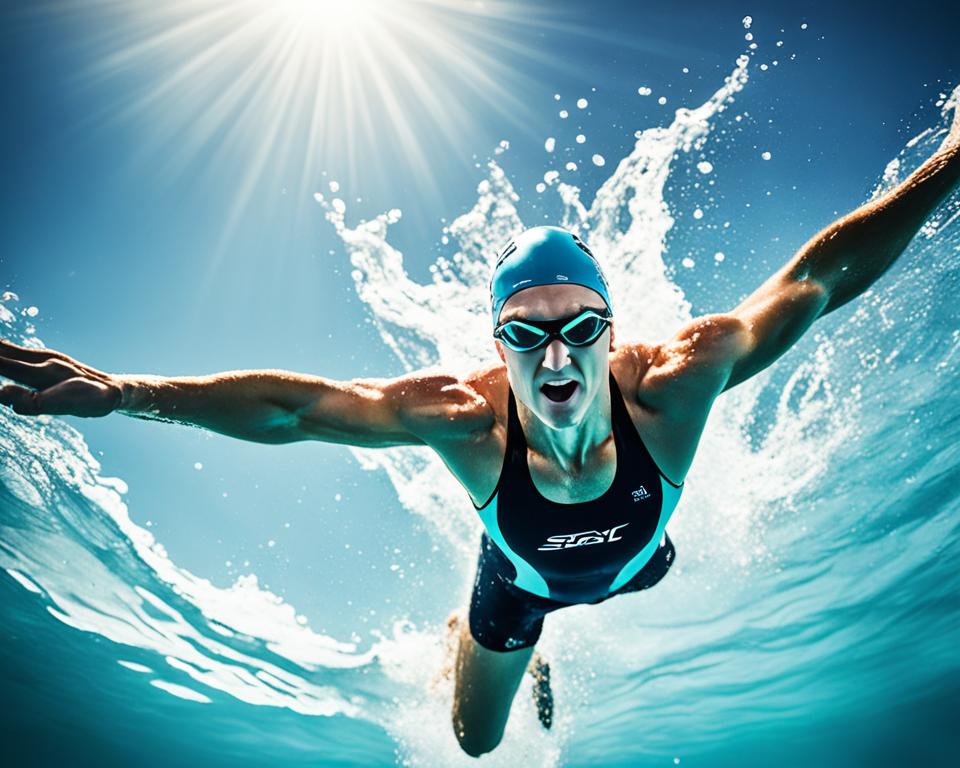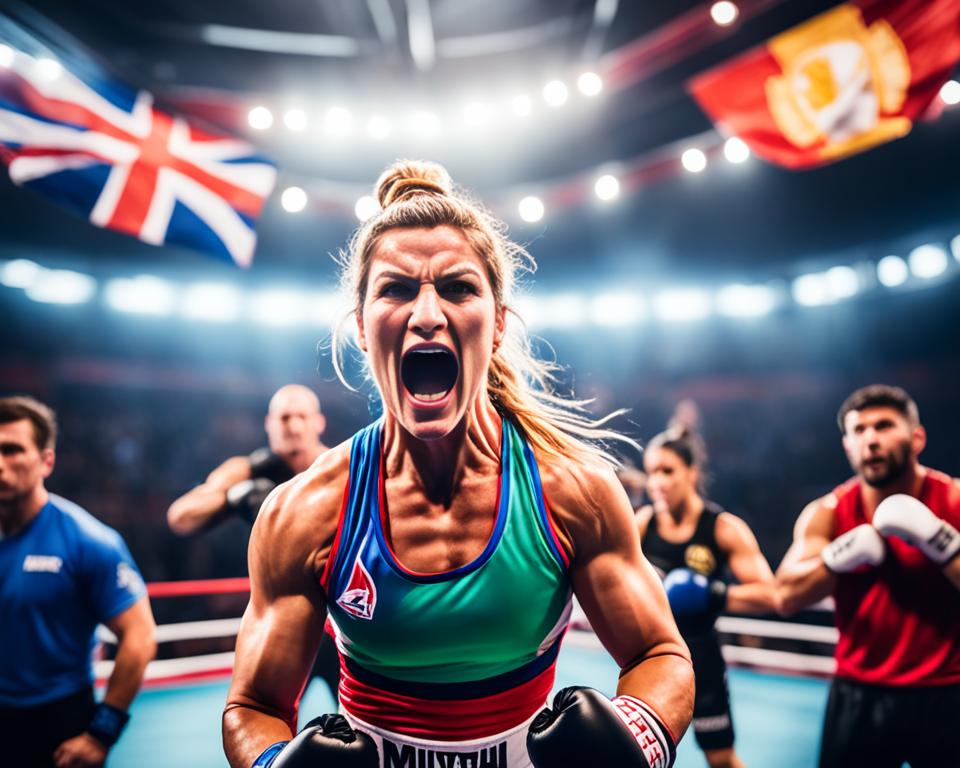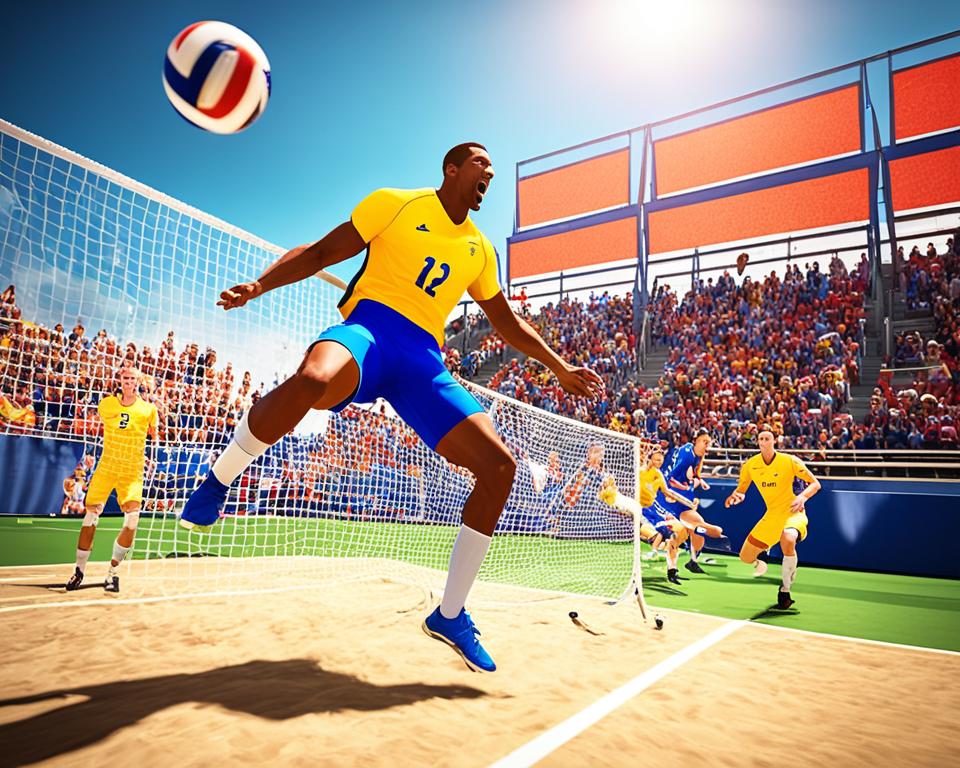Being a swimming athlete means the pool is where you shine. Here, you practice, challenge yourself, and aim for top performance. This guide will show you the key tips to do amazing in the water. It covers everything from setting a strong mindset to nailing the technical parts of your sport.
If you’re either a pro or just starting, this piece is for you. We will share tips to boost your swimming athlete game. You’ll learn about setting goals, mental strength, swim training, and swimming techniques. Ready to jump into the competitive swimming world and aim for victory as an aquatic sports expert?
Now, let’s start exploring how you can succeed in the pool and more. Get ready to show your best as a swimming athlete.
Read more interesting information at ::lesdamesmiami
Introduction to Competitive Swimming
Competitive swimming is a thrilling and tough water sport. It combines physical strength, skill, and mental toughness. This sport includes different strokes, events, and challenges that test athletes’ abilities.
At its core, competitive swimming focuses on four main strokes: freestyle, backstroke, breaststroke, and butterfly. Each requires specific techniques. Swimmers perfect these skills through hours of hard work.
The world of competitive swimming offers a wide variety of events. This includes short 50-meter races to long 1500-meter tests. Swimmers must plan their strategies carefully, manage their stamina, and stay focused to win.
| Stroke | Signature Techniques | Unique Challenges |
|---|---|---|
| Freestyle | Efficient arm recovery, powerful kicks, and streamlined body position | Maintaining a steady pace and rhythm over long distances |
| Backstroke | Simultaneous arm and leg movements, fluid body rotation, and consistent kicking | Navigating the pool while swimming face-up and maintaining a straight course |
| Breaststroke | Unique “frog-like” arm and leg movements, streamlined body position, and timing of the stroke | Developing the strength and flexibility to execute the complex breaststroke technique |
| Butterfly | Powerful and synchronized arm and leg movements, rapid body undulation, and efficient breathing | Sustaining the energy-intensive butterfly stroke over longer distances |
Teams also compete in relay events in competitive swimming. Swimmers need great teamwork, clear communication, and perfect timing to win these races. The relay events bring more excitement and challenge to the sport.
Competitive swimming is thrilling, whether you’re new or experienced. It involves mastering techniques and building mental strength. Athletes and fans alike find this sport truly engaging.
“Swimming is normal for me. I’m relaxed. I’m comfortable, and I know my body.” – Michael Phelps, legendary Olympic swimmer
Developing a Winning Mindset
Being a top swimming athlete is more than just hard workouts. It’s about cultivating a winning mindset. This helps athletes achieve their top performance. The focus here is on setting strong goals and building a strong mind to handle ups and downs.
Goal Setting for Swimming Athletes
For swimming success, clear and reachable goals are key. Make your goals specific and give them deadlines. This keeps you on track and driven. It might be improving your time or making it to a big event. Setting the right goals helps you be the best you can be.
To set good goals, try these tips:
- Break your big goal into smaller, easy-to-reach ones.
- Make sure your goals are SMART: Specific, Measurable, Achievable, Relevant, and Time-bound.
- Check and update your goals as you move forward. They should always push you but also be doable.
- Don’t forget to celebrate your wins, even the small ones. This keeps you motivated.
Mental Toughness and Resilience
For swimming, mental strength and resilience are a must. This sport is tough, both physically and mentally. The ability to recover from setbacks and keep focus under pressure is crucial.
These steps help build mental strength and resilience:
- Use mental images and visualizations to get ready for the big moments.
- Try mindfulness and meditation to boost your concentration and keep your emotions in check.
- See every setback as a chance to grow and get better. This is a key part of a growth mindset.
- Don’t be afraid to ask for help when things get hard. Coaches and teammates are there for support.
With the right focus on goal setting, mental toughness, and resilience, swimming athletes can create a roadmap to success, both in and out of the water.
“The most important thing is to try and inspire people so that they can be great in whatever they want to do.” – Kobe Bryant
Mastering Swimming Techniques
Learning swimming techniques is key for any swimming athlete. It doesn’t matter if you’re just starting or compete often. Improving your strokes doesn’t only make you faster but also more efficient in pool workouts. In this section, we will look at important aspects of each swimming stroke. We’ll also give tips on how to make your swimming techniques top-notch.
Freestyle Technique
The freestyle, also known as the front crawl, is the go-to stroke for many swimmers. To nail it, you should aim for a sleek body line and move your hips and shoulders with each stroke. A strong upward movement of the arms after each stroke is also crucial. Try out drills that help with staying straight in the water, entering your hands smoothly, and kicking right. These will make your freestyle better.
Mastering the Backstroke
Swimming backstroke requires a firm midsection and great body management. Keep your body straight with hips and shoulders level. Nail a steady and rhythmic kick. And use a long, straight, and parallel arm motion when recovering. All these elements together will help you move through the water smoothly.
Perfecting the Breaststroke
- The breaststroke stands out with its frog-like kick and matching arm pulls.
- Avoid unnecessary drag by staying as straight as possible in the water. Kick in a smooth but powerful way. And make sure your hands are doing the same thing at the same time.
- Getting the timings and moves right is key in the breaststroke.
Conquering the Butterfly
Many see the butterfly as the most demanding swimming stroke. To do it well, work on a kick that starts from your chest and moves down to your toes. Your arms should move in a continuous circular motion. Lift your head right up when you breathe. Add dolphin kick and body streamline exercises to your routine. This will better your butterfly swimming techniques.
Getting good at each stroke takes time and effort. But the rewards for any swimming athlete are great. By always working to better your swimming techniques, you’ll swim faster and more effectively. This will boost your competitive swimming game.”
“The key to becoming a great swimmer is to master the fundamentals of each stroke. Perfecting your swimming techniques will unlock your true potential in the pool.”
Swimming Athlete: Training Regimen
Creating a solid training plan is key for swimming athletes. It helps them boost endurance, strength, and overall health. This guide covers vital drills, strength, and conditioning to form an efficient program for competitive swimmers.
Essential Drills for Swimmers
The right swim drills are crucial for mastering technique, speed, and performance. These essential drills bolster a swimmer’s routine:
- Streamline Drills: Focus on the streamline position for better efficiency and less drag. This is important for a smoother swim.
- Kick Drills: Develop a strong kick, an essential part of moving through the water fast.
- Stroke Technique Drills: Improve skills in freestyle, backstroke, breaststroke, and butterfly for better performance.
- Pace Drills: Help swimmers find their best race pace, making speed more consistent and sustainable in races.
Strength and Conditioning for Swimming
Swimmers need more than just swim drills. Adding strength and conditioning builds the power, strength, and endurance they need. The following exercises are vital for success:
- Core Strengthening: Exercises like planks and crunches boost body stability, vital for powerful swimming.
- Upper-Body Strength: Training for arms, shoulders, and upper back improves stroke power and efficiency.
- Lower-Body Strength: Leg exercises enhance kicking and push off the walls with more power.
- Cardiovascular Endurance: HIIT and other aerobic exercises boost the heart and lung strength necessary for the sport.
A complete training program with drills and conditioning lets swimming athletes shine. It unleashes their full ability, driving success in swimming.
Nutrition and Hydration for Swimmers
Being a competitive swimming athlete means taking your nutrition and hydration seriously. It’s key for keeping your body ready to perform well and recover quickly. We’ll dive into what swimmers need to eat and drink to excel in their sport.
Eating right is vital for swimming athletes. You need to keep a careful balance in your diet to match your active life and tough workouts. Here’s the breakdown of what your meals should focus on:
- Carbohydrates: 50-60% of your daily caloric intake to provide energy for your workouts
- Proteins: 20-25% of your daily caloric intake to support muscle recovery and growth
- Fats: 20-25% of your daily caloric intake to support hormone production and overall health
Don’t forget about the water. Competitive swimmers must stay hydrated. Dehydration can mess up your game, causing cramps, tiredness, and less stamina. Make sure to drink up all day and extra around training or meets.
If you want to perform your best, keep these tips in mind:
- Pre-Workout: Have some carbs 1-2 hours before you hit the water for lasting energy.
- During Workout: A drink with electrolytes helps replace what you lose in sweat.
- Post-Workout: A good meal or protein snack in the first 30 minutes after stops muscle damage.
Focus on nutrition and hydration to get your body in top shape for the pool. It’s a winning strategy.
“Proper nutrition and hydration are the foundation of a swimmer’s success. You can’t outwork a bad diet.” – renowned swim coach, Sarah Sjostrom.
Injury Prevention and Recovery
As a competitive swimmer, keeping healthy and free from injuries is key to reaching your goals. Even though swimming is low-impact, it still puts stress on muscles. This is because it’s a repetitive sport.
Common Swimming Injuries
Swimmers often face several common injuries. These include:
- Swimmer’s shoulder: This is when pain and swelling happens in the shoulder joint from overuse.
- Swimmer’s knee: Kicking again and again can lead to knee pain and swelling.
- Swimmer’s back: The lower back gets stiff and painful from the motions of swimming.
- Swimmer’s ankle: The feet’s back and forth movement in water can lead to ankle pain.
Rehabilitation and Recovery Strategies
To prevent and manage injuries, swimming athletes need to rehab and recover well. Here are some key strategies to follow:
- Early intervention: Get help early and follow a plan to stop small issues from getting worse.
- Cross-training: Adding activities like yoga or cycling can make muscles stronger and cuts the chance of injuries.
- Proper rest and recovery: Enough rest is vital for staying injury-free and being at your best.
- Targeted strengthening exercises: Work on specific muscles prone to injury to boost stability and lower future risks.
- Proper technique and form: Right swimming form is key to preventing injuries and doing well in the water.
| Injury | Symptoms | Rehabilitation Strategies |
|---|---|---|
| Swimmer’s Shoulder | Pain and inflammation in the shoulder joint | Physical therapy, exercises for the rotator cuff, and range of motion exercises |
| Swimmer’s Knee | Pain and swelling in the knee joint | Exercises to make the quads and hamstrings stronger, using ice, and taking a break |
| Swimmer’s Back | Pain and stiffness in the lower back | Exercises to strengthen the core, stretch, and improve swimming style |
| Swimmer’s Ankle | Pain and stiffness in the ankle | Movements to help the ankle and exercises to make lower leg muscles stronger |
By focusing on these common injuries and using good rehab and recovery methods, swimmers can reduce setbacks. This helps them keep their performance high in the pool.
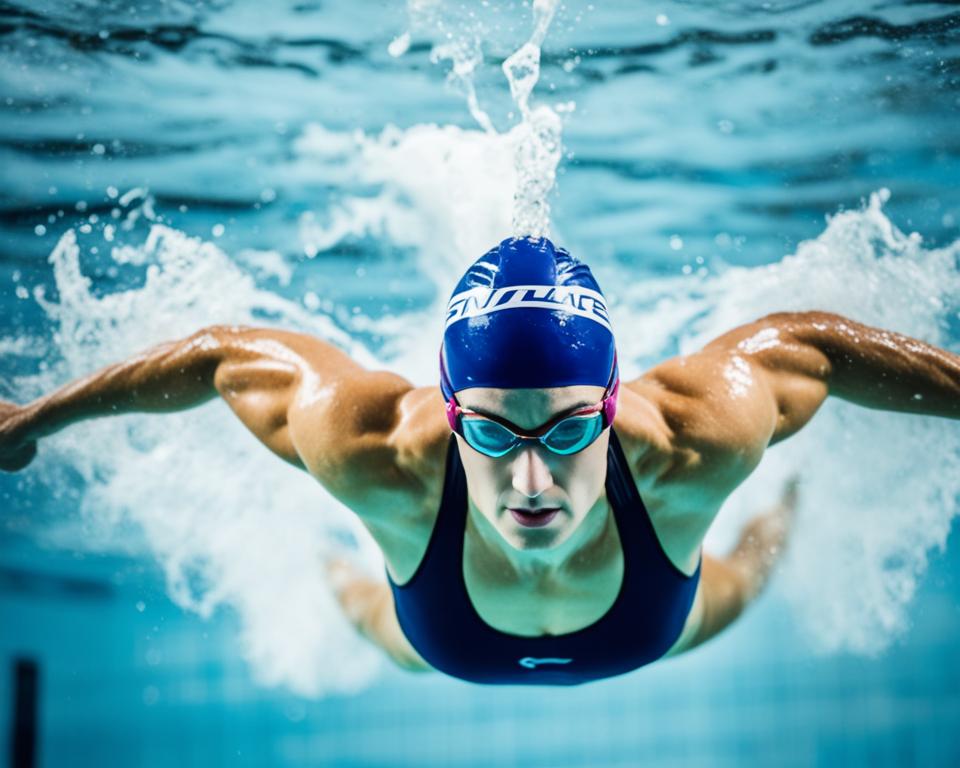
Open Water Swimming Strategies
Usually, swimming races are in controlled pool settings. But open water swimming adds a mix of challenges for athletes. They must deal with the unpredictable conditions of natural bodies of water. This requires special techniques and strategies to succeed.
Swimmers in open water face the challenge of currents and waves. These water environments shift constantly, unlike a still pool. Swimmers must learn to navigate these factors to control their speed and direction.
Another important skill is sighting. This means lifting your head to see where you’re going. In open water without pool walls, swimmers can easily drift off course. Keeping track of their route helps them stay on the right path.
Pacing correctly is crucial for open water swimming. Races here are often much longer than those in pools. Swimmers need to watch their energy and adjust their speed to last through the entire race. Training in pools with interval sessions and sustained endurance efforts is key to getting this right.
| Open Water Swimming Strategies | Key Considerations |
|---|---|
| Navigating Currents and Waves | Developing the ability to read and adapt to environmental factors |
| Sighting Techniques | Periodically lifting the head to check position and direction |
| Pacing Strategies | Mindful energy expenditure and sustained endurance |
By understanding and refining these strategies, competitive swimming athletes can improve their performance. They will be better equipped to tackle the distinct challenges of open water swimming.
“Open water swimming is not just about physical strength, but also about mental agility and the ability to adapt to constantly changing conditions.”
Preparing for Swim Meets
Getting ready for competitive swimming is a detailed process. It involves perfecting your pre-race routine and mental readiness. As a swimming athlete, knowing how to warm up and prepare your mind is key. This ensures you’re at your peak during the swim meet.
Pre-Race Routines and Warm-ups
A strong pre-race routine impacts your swim meet performance. Start by making sure you’re at the pool early. This gives you time for warm-up exercises. Your body will gradually prep for your race.
For your warm-up, combine light cardio, dynamic stretching, and specific swimming drills. This mix prepares your body by loosening muscles and getting your heart rate up. It’s key for the challenges of the race ahead.
- Begin with 10-15 minutes of light swim, focusing on good form.
- Add dynamic stretching to prep your shoulders, hips, and core.
- Then, do drills to work on your technique and muscle memory for your events.
The pre-race routine isn’t just physical, it’s also mental. Spend some time visualizing your race. Think about your moves and imagine yourself winning. This boosts your confidence and helps you stay focused for a great swim meet.
“The race is won or lost in the mind long before I ever start swimming.”
– Michael Phelps, legendary swimming athlete and Olympic gold medalist
Essential Swimming Gear
As a competitive swimming athlete, the right gear is crucial for peak performance. This includes everything from swimming gear to technical accessories. Having the right stuff helps you do your best and enjoy your time in the water.
Swimsuits: The Foundation
A great swimsuit is the base for any swimmer. Choose one that’s hydrodynamic, comfy, and offers the support you need. It should be made of light, stretchy fabric that cuts down on resistance and lets you move freely.
Goggles: Clarity and Protection
Your eyesight and eye protection are vital while swimming. Get goggles with a good fit, an anti-fog feature, and UV protection. These qualities keep your vision clear and protect your eyes while you swim.
Swimming Caps: Streamlining and Comfort
A properly fitting swimming cap reduces drag and manages your hair. Go for caps made of silicone or latex. They fit well and make your swim more streamlined.
Technical Accessories: Enhancing Performance
Using items like kickboards or swim paddles can be a big help. They target different muscle groups and boost your technique. Adding these accessories to your training can really step up your game.
| Essential Swimming Gear | Description | Benefits |
|---|---|---|
| Swimsuit | High-quality, hydrodynamic suit | Reduces drag, provides support and compression |
| Goggles | Comfortable, secure fit with anti-fog and UV protection | Enhances vision and protects eyes |
| Swimming Cap | Silicone or latex, snug fit | Streamlines the body, keeps hair out of face |
| Technical Accessories | Kickboards, pull buoys, swim paddles | Targets specific muscle groups, improves technique |
For competitive swimming, the right swimming gear is a must. Carefully choosing your gear can make swimming more efficient and enjoyable.
Selecting a Swimming Coach
For competitive swimming, a great coach is essential for a swimmer’s success. They help perfect technical skills. Plus, they create a supportive and motivating atmosphere.
Qualities of an Effective Swim Coach
Choosing the right swimming coach means looking for standout qualities. Let’s see what makes a coach great:
- Technical Expertise: A top coach knows their stuff about swimming. They understand the science behind it and can spot what you need to work on.
- Coaching Philosophy: The coach’s training and support style must match your goals. You need someone who can clearly outline their approach to help you succeed.
- Communication and Motivation: Good coaches motivate their swimmers with clear, positive feedback. They create a space where swimmers can thrive.
- Experience and Credentials: A coach’s past success and qualifications show their skill. Look for someone with a solid history of helping swimmers do their best.
- Athlete-Centered Approach: The best coaches focus on you as an individual. They adapt their methods to suit your specific needs and goals.
Evaluating these qualities is key to finding a coach who supports your competitive swimming journey.
| Coaching Skill | Importance for Competitive Swimmers |
|---|---|
| Technical Expertise | Ability to identify and correct technical flaws, improve stroke mechanics, and enhance overall swimming performance. |
| Motivational Skills | Keeps swimmers engaged, focused, and driven to push their limits, even during challenging training sessions. |
| Experience | Proven track record of developing successful competitive swimming athletes and guiding them to achieve their goals. |
| Personalized Approach | Tailors training plans and coaching strategies to address the unique needs and strengths of each individual swimmer. |
Searching for these qualities can pair you with a coach who elevates your swimming performance.
Building a Supportive Team Environment
In competitive swimming athlete circles, the importance of a team environment is huge. Even though swimming is seen as solo, a strong team offers support and shared stories. This boosts swimming athletes in ways they didn’t imagine.
Being part of a team allows for collaboration and teamwork. While swimming is mainly individual, working with teammates can multiply efforts. This teamwork often leads swimming athletes to break their personal barriers.
A big plus of a good team environment is communication. Through meetings and honest talks, swimming athletes get a chance to voice concerns and find solutions together. This sets the stage for new training ideas and a better understanding among teammates.
A strong team bond offers belonging and camaraderie to swimming athletes. Feeling close to their team boosts their efforts. It also encourages everyone to work harder, ensuring shared victories.
So, the team environment in competitive swimming is crucial. It’s not just about winning; it’s about enhancing each swimming athlete’s journey. A supportive, united team can help these athletes achieve their best, both in and out of the water.
Swimming Athlete: Managing Setbacks
As a competitive swimming athlete, expect to face setbacks and challenges. These can be injuries, poor performances, or personal issues. The key is how you deal with these and bounce back stronger.
It’s crucial for swimming athletes to be resilient>. A positive mindset helps. See failures as chances to grow and get better.
Strategies for Managing Setbacks
- Embrace a Growth Mindset: Don’t see setbacks as the end, but as hurdles to jump over. Believe you can get better and stronger by learning from these challenges.
- Seek Support: Don’t be afraid to lean on your support system. This includes your coach, teammates, and mental health experts. They can offer advice and help you through tough times.
- Adjust Your Goals: It’s okay to change your goals when things get tough. Breaking them into smaller steps can keep you on track. This is great for staying motivated despite setbacks.
- Reflect and Learn: Think about what went wrong and why. Learning from mistakes makes you smarter and more prepared for the future.
- Prioritize Self-Care: Never forget to take care of yourself. Relaxation and stress relief are key. Meditate, keep a journal, or do something you love away from swimming.
Setbacks are just part of your swimming journey. With resilience and smart strategy, you’re turning hurdles into steps for growth and success.
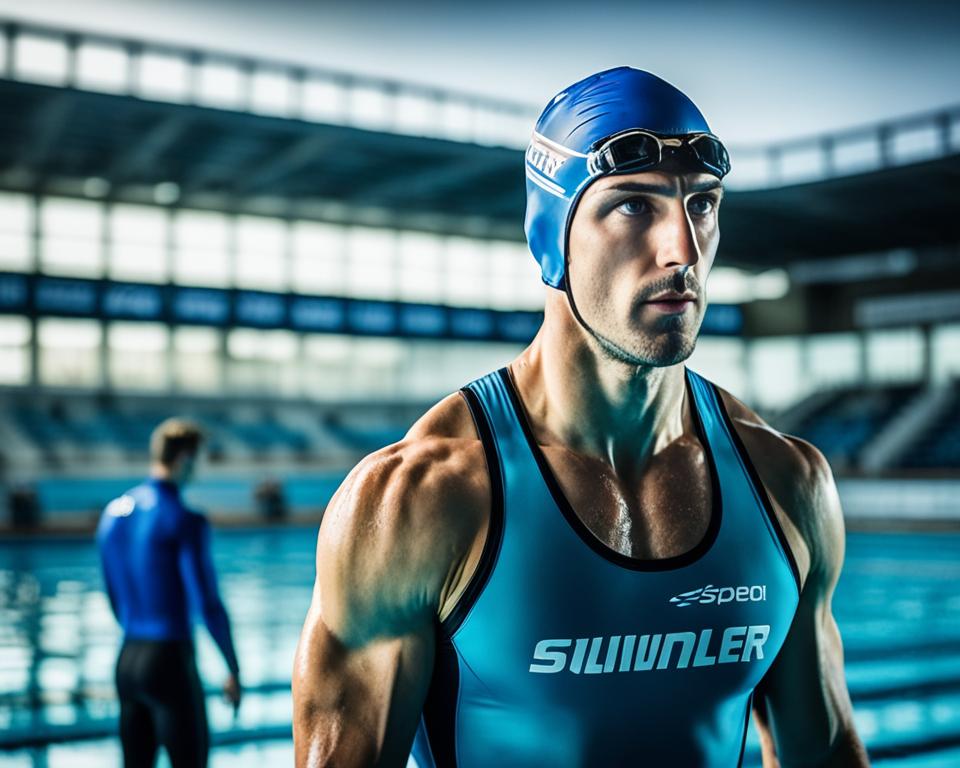
| Setback | Resilience Strategy | Outcome |
|---|---|---|
| Injury | Seek professional guidance, follow rehabilitation plan, and gradually return to training | Stronger and more aware of injury prevention |
| Poor Performance | Analyze performance, adjust training, and focus on progress rather than results | Improved technique and mental toughness |
| Personal Challenges | Prioritize self-care, seek support, and maintain a balanced lifestyle | Renewed passion and commitment to the sport |
“The true champion is not the one who never fails, but the one who rises up after every fall.”
With resilience and strong strategies, swimming athletes can beat setbacks and keep pushing for success.
Balancing Academics and Swimming
Swimming athletes often find it tough to keep up with their academic studies and competitive swimming. Yet, they can excel in both by managing their time well. Effective time management is key. It lets them fit in necessary practice and study time.
Creating a detailed schedule is crucial. It should allow time for practice, weight training, and study. By setting realistic deadlines, they can handle their swimming and academic requirements.
Coming up with a detailed schedule helps them manage their time wisely. It ensures they meet both their swimming and school needs without falling short. This kind of planning takes the stress out of trying to do everything at once.
Aside from time management, swimming athletes must learn to make tough choices. They might have to choose studying for an important test over a practice. Or skip a party to work on a paper. Knowing what’s most important and making it clear to others helps a lot.
Finding the right balance between school, swimming, and life is important. It’s not just about working hard but also about taking time to rest and relax. This helps keep stress low and performance high.
| Strategies for Balancing Academics and Swimming | Benefits |
|---|---|
|
|
Following these steps can help swimming athletes find a good balance. This way, they can reach their goals in both swimming and school.
“The key to success in both academics and swimming is learning to prioritize your responsibilities and maintain a healthy work-life balance. It’s not easy, but with the right strategies, it’s definitely achievable.”
Conclusion
This guide has shown that top swimming athletes use many strategies to win. They focus on their mindset and skills, perfect their training, and face swimming’s unique hurdles. This highlights the need for a wide range of skills and knowledge to succeed in swimming.
For those looking to dive deeper into swimming or start their journey, this guide offers key insights and advice. It talks about setting goals, staying strong mentally, and smart training. By following these principles, swimmers can unleash their full potential and achieve great success.
The road to swimming success is tough but rewarding. With a positive attitude, hard work, and the right guidance, anyone can triumph in the pool. It’s about improving your skills, trusting your coaches, and always aiming to be better. Stay dedicated, and your efforts will lead to personal victories, winning medals, and a lifelong passion for swimming.
